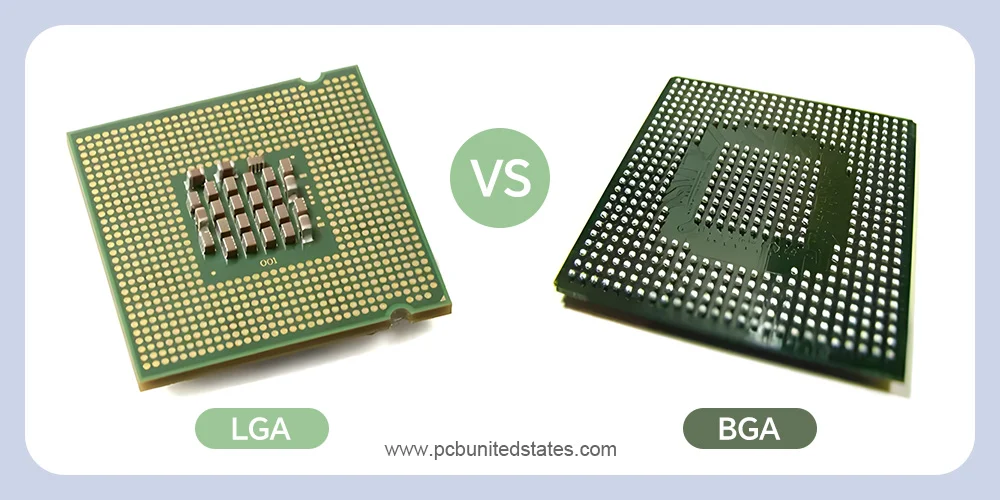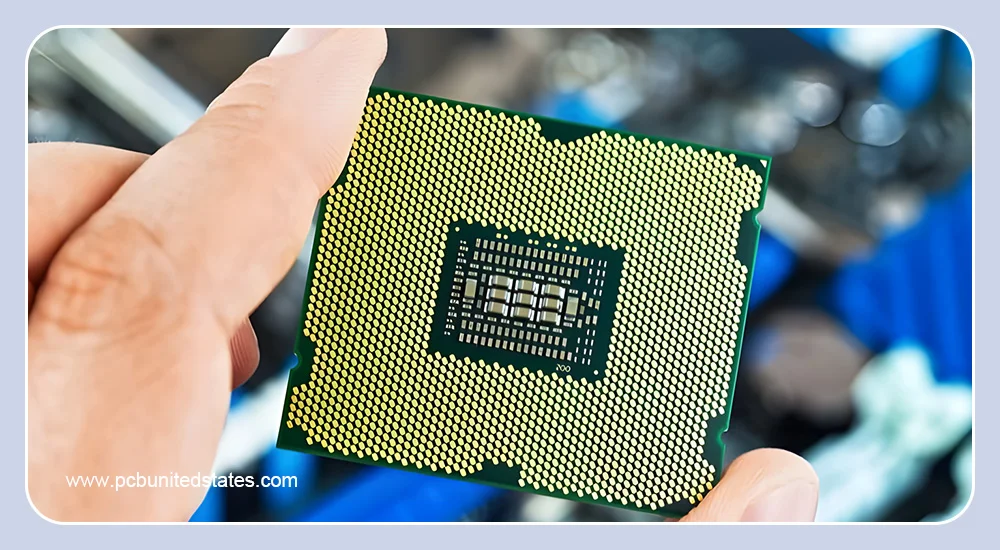LGA vs BGA are two common types of IC packages, which are designed to solve a hard problem: connecting integrated circuits with a large number of input/output pins to the circuit board. LGA (Land Grid Array) has grid-like flat pads on the bottom aligned with the PCB pads. While BGA (Ball Grid Array) uses grid-like pre-attached solder balls, requiring a reflow process to attach the pads. As chip designs become increasingly complex, choosing the right package is now even more important. This blog deeply reveals the differences between LGA vs BGA, finally providing a practical guide on when to use each.
LGA vs BGA: What Are the Key Technical Differences?
Before choosing between LGA vs BGA, it’s important to know their differences. In this part, we will reveal the top 7 differences to help you understand them thoroughly.

Electrical Connections
This is the main difference between LGA vs BGA – how to establish the electrical connection. In the LGA package, the grid-like contacts beneath the device are designed to match the corresponding PCB pads, establishing the connection between the circuit board and component. Or, it can be connected to the PCB via a socket, which is preferred for situations like frequent component replacement and upgradation.
In the BGA package, the small, grid-like solder balls instead of pins are on the bottom device’s surface, providing both mechanical support and electrical connection.
Pitch and Size
The pitch means the distance between each contact or solder ball. The pitch of solder balls in BGA packages is smaller than that of pads in LGA packages. Thus, BGA is ideal for space-saving devices, achieving high ball density or pin counts in compact designs.
As for LGA, it usually takes up more space due to its contact pad architecture. Besides, the socket design also needs to occupy additional space.
Thermal Management
LGA vs BGA differ in thermal management. Generally, Ball Grid Array has better heat dissipation than Land Grid Array. This is because the solder balls provide a more even and effective heat transmission path. They inherently manage heat very well, which is critical for high-power devices.
LGAs, which dissipate heat through metal contact pads, have less efficient thermal management. However, it can use heat sinks to dissipate heat, improving heat transfer.
Signal Integrity
Both LGA vs BGA provide excellent electrical performance. With short electrical paths, BGA can maintain low inductance and high signal integrity. While soldered LAG has a shorter interconnect path, making it ideal for microwave systems and RF devices. However, for socketed LGA, the situation may be different. The parasitic inductance can be introduced because of potential air gaps and spring contacts. Therefore, socketed LGAs are not very suitable for sensitive analog signals or ultra-high-speed devices. But it’s not completely impossible. If designed well, they can still be used in digital applications up to GHz.
Installation Methods for BGA vs LGA
BGA packages commonly apply reflow soldering to solidify the components. Once soldered, the device is permanently fixed and cannot be easily removed. In contrast, LGA packages can be either soldered or socketed. Socketed LGAs use a latching mechanism to secure the component, enabling quick installation and easy replacement without heat or specialized tools.
Rework and Inspection
The pins of the LGA package can be seen and accessed, which is more convenient for repairing and inspecting. If rework is needed, it’s easy to remove and replace the components. But reworking BAG is challenging work. Since the solder balls of Ball Grid Array are hidden and solidified under the component, it usually requires professional skills and tools to deballing and reball. This process results in high labor costs. X-ray inspection is often the first choice for inspecting Land Grid Array and Ball Grid Array packages to reveal defects, including weak solder joints and bridging.
Applications in LGA vs BGA
LGA packages are commonly used for CPUs and servers where replacement and upgradation are often desired, such as Microcontrollers, FPGA and ASICs. BGA packages are found in smartphones, tablets, and high-performance devices where space is limited and permanence is acceptable.
LGA vs BGA Package
| Aspects | LGA (Land Grid Array) | BGA (Ball Grid Array) |
| Connection | Flat gold-plated contact pads | Solder balls |
| Pitch | Larger | Smaller |
| Board Density | Moderate (occupies more board area) | High (supports compact layouts) |
| Repairability | Easy to rework | Hard to rework |
| Upgrade Capability | Easily replaceable via socket | Fixed after soldering |
| Durability | Durable and maintainable through socket connection | Highly durable but permanently fixed |
| Installation Methods | Soldering or socketed | Reflow soldering |
| Inspection Challenge | Low, pins are easy to access | High, requiring X-ray inspection |
| Thermal Management | Good | Excellent |
| Cost | Higher socket cost | Higher manufacturing cost |
LGA vs BGA: What Are the Key Advantages and Disadvantages?

Land Grid Array Key Pros
- Easier to replace or upgrade when using a socketed LGA, commonly found in telecom devices, servers, and desktop PCs.
- Visible contacts allow easier inspection and testing of connection quality.
- Lower manufacturing costs with fewer handling steps and less material required.
Land Grid Array Key Cons
- Thermal performance depends on effective cooling solutions, such as heat sinks.
- Lower boarddensity due to pins occupying more space than BGA solder balls.
- Prone to small pin bendingif not handled properly, resulting in damage and requiring expensive repairs.
Ball Grid Array Key Pros
- High board density, suitable for compact devices, such as tablets, smartphones, etc.
- Excellent thermal and electrical performance enabled by direct, short connections that minimize resistance and enhance heat dissipation.
- Allow to deball and reball, replacing worn solder balls.
Ball Grid Array Key Cons
- Permanent installation,not easily replaceable.
- Inspection requires X-ray imaging due to the hidden solder balls on the underside of the component.
- Difficult repair due to hidden solder balls that require experienced skills and specialized tools.
- Higher cost to manufacture with extra process and materials needed for bonding solder balls.

Choosing Between LGA and BGA Package
Now that you know the differences, pros, and cons of LGA vs BGA, do you know which one you should choose? If not, you are not alone. You have to consider many factors (application requirements, thermal performance, signal integrity, etc.) thoroughly before making a decision.
When a high pin count is required:
Decision: BGA package is an ideal choice.
Reasoning: It supports higher connection density, making it suitable for components with high pins.
When a low pin count is sufficient:
Decision: LGA is enough.
Reasoning: Land Grid Array can offer good mechanical support and is easy to inspect the connections.
When excellent thermal performance is needed:
Decision: Choose BGA without any hesitation.
Reasoning: Ball Grid Array can dissipate heat with solder balls more effectively than Land Grid Array.
When signal integrity is important:
Decision: BGA can satisfy your requirement.
Reasoning: Short interconnect paths reduce parasitic capacitance and inductance, ensuring better signal quality.
When repairability and upgrades are important:
Decision: Choose LGA, preferably socketed LGA.
Reasoning: LGA pins are visible and accessible, allowing easier repair and replacement. If using a socketed LGA, you can achieve quick component swaps and upgrades without soldering.
When mechanical stability is critical:
Decision: Choose LGA.
Reasoning: LGA packages perform better than BGA packages in terms of shock, vibration, or mechanical stress.
When space is a major factor (space-constrained designs):
Decision: Choose Ball Grid Array.
Reasoning: Smaller than LGA packages, BGAs are well-suited for designs where PCB space is constrained.
When cost is a major factor (cost-sensitive projects):
Decision: LGA is less expensive than BGA.
Reasoning: Lower manufacturing cost, suitable for budget-conscious applications.
| Occasion | LGA (Land Grid Array) | BGA ( Ball Grid Array) |
| Lower pin count | ✔ | |
| High pin count | ✔ | |
| Easy to repair | ✔ | |
| Cost-sensitive | ✔ | |
| High mechanical stability | ✔ | |
| High thermal performance | ✔ | |
| High signal integrity | ✔ | |
| Space-constrained | ✔ |
Last Words
When talking to LGA vs BGA, it’s difficult to say which is better. The choice all depends on the specific needs of your device. BGA packages are suited to compact designs with high density and high performance, while LGA packages are ideal for applications requiring repair, upgrades, or quick replacement. When choosing between LGA vs BGA packages, many factors require careful consideration, such as thermal management, signal integrity, cost, space, repairability, etc. The final choice is the result of weighing these factors. If you’re still unsure, MOKOPCB is here to help, guiding you in selecting a package that meets your performance and cost goals. Contact us today for expert support.

